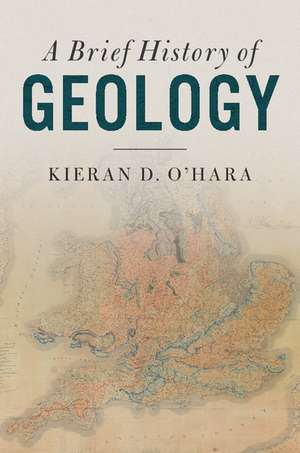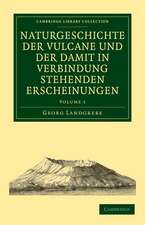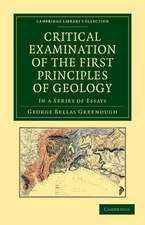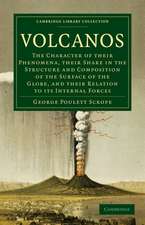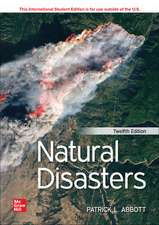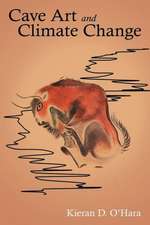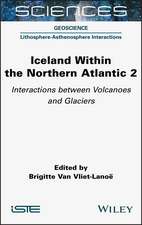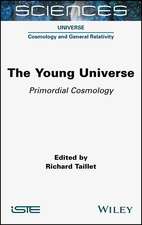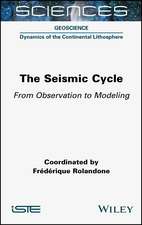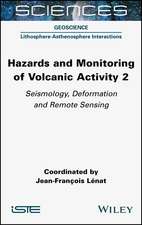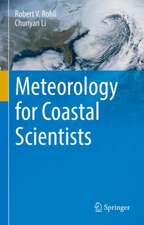A Brief History of Geology
Autor Kieran D. O'Haraen Limba Engleză Hardback – 18 apr 2018
Preț: 244.49 lei
Nou
Puncte Express: 367
Preț estimativ în valută:
46.78€ • 50.03$ • 39.01£
46.78€ • 50.03$ • 39.01£
Carte tipărită la comandă
Livrare economică 18 aprilie-02 mai
Preluare comenzi: 021 569.72.76
Specificații
ISBN-13: 9781107176188
ISBN-10: 1107176182
Pagini: 274
Ilustrații: 52 b/w illus. 5 maps 9 tables
Dimensiuni: 159 x 236 x 17 mm
Greutate: 0.59 kg
Editura: Cambridge University Press
Colecția Cambridge University Press
Locul publicării:New York, United States
ISBN-10: 1107176182
Pagini: 274
Ilustrații: 52 b/w illus. 5 maps 9 tables
Dimensiuni: 159 x 236 x 17 mm
Greutate: 0.59 kg
Editura: Cambridge University Press
Colecția Cambridge University Press
Locul publicării:New York, United States
Cuprins
Preface; 1. Major nineteenth-century players; 2. Towards a geologic time scale; 3. A vestige of a beginning: the age of the Earth; 4. The origin of Igneous rocks; 5. Tectonics in crisis; 6. Continental drift; 7. Plate tectonics; 8. Isotope and trace element geology; 9. Ice ages and ice cores; 10. Geology and evolution of the Moon; 11. Welcome to the anthropocene: a man-made epoch?; 12. The structure of geological revolutions; Index.
Recenzii
'The nearly four-century existence of geology as a concept - 'the study of the Earth with its Furniture' as it was first put - has been mired in periods of uncertainty, revolution, speculation and controversy. Kieran D. O'Hara has tied it all up in a concise, neatly arranged and highly readable summary, essential to all who want to know more of the fascinating story of this most fundamental of sciences.' Simon Winchester, author of The Map That Changed the World
'O'Hara does a great job of covering both the old (late 1800s) and the new (1960–70) history of geology. Included are informative, but concise, biographies of all the major players in the nineteenth and twentieth centuries. The author shows very clearly how Wegner's continental drift - which was not originally accepted by the scientific community - came together with Harry Hess's seafloor spreading in the 1970s, and led to the 'Great Plate Tectonic Revolution' in the Earth Sciences. I really liked the chapter on isotopic dating, where the author clearly explains how geologists learned to use isotopes to date geologic events - no other book on the history of geology illustrates this so clearly. And another outstanding feature of the book is Chapter four, where the author shows how the geologic community used experimental results to better understand the origin of magmas.' Kent Condie, New Mexico Institute of Mining and Technology
'O'Hara does a great job of covering both the old (late 1800s) and the new (1960–70) history of geology. Included are informative, but concise, biographies of all the major players in the nineteenth and twentieth centuries. The author shows very clearly how Wegner's continental drift - which was not originally accepted by the scientific community - came together with Harry Hess's seafloor spreading in the 1970s, and led to the 'Great Plate Tectonic Revolution' in the Earth Sciences. I really liked the chapter on isotopic dating, where the author clearly explains how geologists learned to use isotopes to date geologic events - no other book on the history of geology illustrates this so clearly. And another outstanding feature of the book is Chapter four, where the author shows how the geologic community used experimental results to better understand the origin of magmas.' Kent Condie, New Mexico Institute of Mining and Technology
Notă biografică
Descriere
Places the history of geology into the larger context of the history of science in general.
